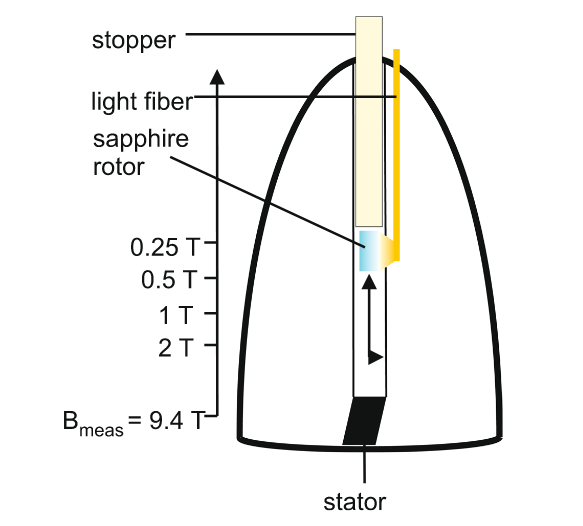Nuclear hyperpolarization in Field-cycling solid-state NMR

Strong nuclear spin-hyperpolarization irradiated by light-inducing has been investigated for decades. The biological applications on protein folding, surface accessibility, molecular interactions, etc. have been conducted and investigated in this manner. Despite liquid-state applications, the solid-state NMR has also employed such a manner additionally combining the magic-angle spinning (MAS) to gain the high-resolution on solid-state spectra. The group of Prof. Matysik demonstrated the capability of MAS field-cycling solid-state NMR on determination of field-dependent CIDNP (Chemical Induced Dynamics Polarization) effect on bacterial Rhodobactor(R.) spheroids wildtype. In their studies of field range from 0.2 to 20 Tesla, the reaction center of bacterial Rhodobactor(R.) spheroids wildtype showed the significant CIDNP enhancement on the magnetic field 5 Tesla, i.e. around 200MHz. Shown figure is the simulated trend for the enhancement due to the solid-state photo-CIDNP effect as a function of the magnetic field for two selected nuclei from the donor (PM) and the acceptor (Φ) cofactors. The presented curves are donor and accpetor on 4-13C-δ-Aminolevulinic acid (4-ALA) in bacterial Rhodobactor(R.) spheroids wildtype. [Ref: supplimental data from Scientific Reports 7, 12111 (2017)] The following studies open different windows of applications on field-cycling NMR on the study of nuclear hyperpolarization.
Related Literature
Field-cycling NMR with high-resolution detection under magic-angle spinning: determination of field-window for nuclear hyperpolarization in a photosynthetic reaction center
Daniel Graesing, Pavlo Bielytskyi, Isaac F. C spedes-Camacho1, A. Alia, Thorsten Marquardsen, Frank Engelke & Joerg Matysik
Scientific Reports 7, 12111 (2017)

Several parameters in NMR depend on the magnetic field strength. Field-cycling NMR is an elegant way to explore the field dependence of these properties. The technique is well developed for solution state and in relaxometry. Here, a shuttle system with magic-angle spinning (MAS) detection is presented to allow for field-dependent studies on solids. The function of this system is demonstrated by exploring the magnetic field dependence of the solid-state photochemically induced nuclear polarization (photo-CIDNP) effect. The effect allows for strong nuclear spin-hyperpolarization in light-induced spincorrelated radical pairs (SCRPs) under solid-state conditions. To this end, 13C MAS NMR is applied to a photosynthetic reaction center (RC) of the purple bacterium Rhodobacter (R.) sphaeroides wildtype (WT). For induction of the effect in the stray field of the magnet and its subsequent observation at 9.4 T under MAS NMR conditions, the sample is shuttled by the use of an aerodynamically driven sample transfer technique. In the RC, we observe the effect down to 0.25 T allowing to determine the window for the occurrence of the effect to be between about 0.2 and 20 T.
Nuclear spin-hyperpolarization generated in a flavoprotein under illumination: experimental field-dependence and theoretical level crossing analysis
Yonghong Ding, Alexey S. Kiryutin, Alexandra V. Yurkovskaya, Denis V. Sosnovsky, Renad Z. Sagdeev, Saskia Bannister, Tilman Kottke, Rajiv K. Kar, Igor Schapiro, Konstantin L. Ivanov & Joerg Matysik
Scientific Reports 9, 18436 (2019)

The solid-state photo-chemically induced dynamic nuclear polarization (photo-CIDNP) effect generates non-equilibrium nuclear spin polarization in frozen electron-transfer proteins upon illumination and radical-pair formation. The effect can be observed in various natural photosynthetic reaction center proteins using magic-angle spinning (MAS) nuclear magnetic resonance (NMR) spectroscopy, and in a flavin-binding light-oxygen-voltage (LOV) domain of the blue-light receptor phototropin. In the latter system, a functionally instrumental cysteine has been mutated to interrupt the natural cysteine involving photochemistry allowing for an electron transfer from a more distant tryptophan to the excited flavin mononucleotide chromophore. We explored the solid-state photo-CIDNP effect and its mechanisms in phototropin-LOV1-C57S from the green alga Chlamydomonas reinhardtii by using field cycling solution NMR. We observed the 13C and, to our knowledge, for the first time, 15N photo-CIDNP signals from phototropin-LOV1-C57S. Additionally, the 1H photo-CIDNP signals of residual water in the deuterated buffer of the protein were detected. The relative strengths of the photo-CIDNP effect from the three types of nuclei, 1H, 13C and 15N were measured in dependence of the magnetic field, showing their maximum polarizations at different magnetic fields. Theoretical level crossing analysis demonstrates that anisotropic mechanisms play the dominant role at high magnetic fields.
Magnetic Field Dependence of Photo-CIDNP MAS NMR on Photosynthetic Reaction Centers of Rhodobacter sphaeroides WT
Shipra Prakash, Alia, Peter Gast, Huub J. M. de Groot, Gunnar Jeschke, and Jörg Matysik
J. Am. Chem. Soc. (2005) 127, 41, 14290–14298

Photochemically induced dynamic nuclear polarization (photo-CIDNP) is observed in frozen and quinone depleted photosynthetic reaction centers of the purple bacteria Rhodobacter sphaeroides wild type (WT) by 13C solid-state NMR at three different magnetic fields. All light-induced signals appear to be emissive at all three fields. At 4.7 T (200 MHz proton frequency), the strongest enhancement of NMR signals is observed, which is more than 10 000 above the Boltzmann polarization. At higher fields, the enhancement factor decreases. At 17.6 T, the enhancement factor is about 60. The field dependence of the enhancement appears to be the same for all nuclei. The observed field dependence is in line with simulations that assume two competing mechanisms of polarization transfer from electrons to nuclei, three-spin mixing (TSM) and differential decay (DD). These simulations indicate a ratio of the electron spin density on the special pair cofactors is 3:2 in favor of the L-BChl during the radical cation state. The good agreement of simulations with the experiments raises expectations that artificial solid reaction centers can be tuned to show photo-CIDNP in the near future.